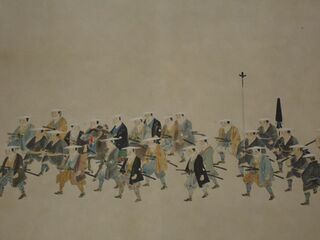Difference between revisions of "Odagiri Shunko"
| Line 7: | Line 7: | ||
Odagiri Shunkô was a samurai and court painter in service to the [[Owari Tokugawa clan|Tokugawa]] lords of [[Owari han]] ([[Nagoya]]) in the late [[Edo period|Edo]] and early [[Meiji period]]s. | Odagiri Shunkô was a samurai and court painter in service to the [[Owari Tokugawa clan|Tokugawa]] lords of [[Owari han]] ([[Nagoya]]) in the late [[Edo period|Edo]] and early [[Meiji period]]s. | ||
| − | He studied under [[Mori Koga|Mori Kôga]]<!--森高雅-->. He served in a number of low- to mid-ranking positions, including as ''[[umamawari]]'' (guard), ''shoinban'' (guard of the study), and other positions. In [[1865]], he produced two significant paintings at the order of the domain: ''Owari shi'' and ''Mino shi''. Along with [[Okada Kei]]<!--岡田啓--> he also produced the ''Owari meisho zue'', a collection of [[meisho|famous places]] of the Owari area. His other works include ''Owari eiketsu gaden''<!--尾張英傑画伝-->, a handscroll painting of the lord's ''[[sankin kotai|sankin kôtai]]'' procession, and a number of maps of [[Owari province|Owari]] and other provinces, as well as works depicting the [[Ryukyuan embassies to Edo]], including the ''[[Ryukyu gashi|Ryûkyû gashi]]'' and ''[[Meiyo kenbun zue|Meiyô kenbun zue]]''. | + | He studied under [[Mori Koga|Mori Kôga]]<!--森高雅--> and [[Kori Tanenobu|Kôri Tanenobu]]<!--高力種信, aka 猿猴庵 Enkôan-->.<ref>Yokoyama Manabu 横山学, ''Ryûkyû koku shisetsu torai no kenkyû'' 琉球国使節渡来の研究, Tokyo: Yoshikawa kôbunkan (1987), 211n18.</ref> He served in a number of low- to mid-ranking positions, including as ''[[umamawari]]'' (guard), ''shoinban'' (guard of the study), and other positions. In [[1865]], he produced two significant paintings at the order of the domain: ''Owari shi'' and ''Mino shi''. Along with [[Okada Kei]]<!--岡田啓--> he also produced the ''Owari meisho zue'', a collection of [[meisho|famous places]] of the Owari area. His other works include ''Owari eiketsu gaden''<!--尾張英傑画伝-->, a handscroll painting of the lord's ''[[sankin kotai|sankin kôtai]]'' procession, and a number of maps of [[Owari province|Owari]] and other provinces, as well as works depicting the [[Ryukyuan embassies to Edo]], including the ''[[Ryukyu gashi|Ryûkyû gashi]]'' and ''[[Meiyo kenbun zue|Meiyô kenbun zue]]''. |
{{stub}} | {{stub}} | ||
| Line 13: | Line 13: | ||
==References== | ==References== | ||
*"[https://kotobank.jp/word/%E5%B0%8F%E7%94%B0%E5%88%87%E6%98%A5%E6%B1%9F-1063366 Odagiri Shunkô]," ''Nihon jinmei daijiten'' 日本人名大辞典, Kodansha 2009. | *"[https://kotobank.jp/word/%E5%B0%8F%E7%94%B0%E5%88%87%E6%98%A5%E6%B1%9F-1063366 Odagiri Shunkô]," ''Nihon jinmei daijiten'' 日本人名大辞典, Kodansha 2009. | ||
| + | <references/> | ||
[[Category:Samurai]] | [[Category:Samurai]] | ||
[[Category:Artists and Artisans]] | [[Category:Artists and Artisans]] | ||
[[Category:Edo Period]] | [[Category:Edo Period]] | ||
Revision as of 18:10, 14 March 2016

Odagiri Shunkô was a samurai and court painter in service to the Tokugawa lords of Owari han (Nagoya) in the late Edo and early Meiji periods.
He studied under Mori Kôga and Kôri Tanenobu.[1] He served in a number of low- to mid-ranking positions, including as umamawari (guard), shoinban (guard of the study), and other positions. In 1865, he produced two significant paintings at the order of the domain: Owari shi and Mino shi. Along with Okada Kei he also produced the Owari meisho zue, a collection of famous places of the Owari area. His other works include Owari eiketsu gaden, a handscroll painting of the lord's sankin kôtai procession, and a number of maps of Owari and other provinces, as well as works depicting the Ryukyuan embassies to Edo, including the Ryûkyû gashi and Meiyô kenbun zue.
References
- "Odagiri Shunkô," Nihon jinmei daijiten 日本人名大辞典, Kodansha 2009.
- ↑ Yokoyama Manabu 横山学, Ryûkyû koku shisetsu torai no kenkyû 琉球国使節渡来の研究, Tokyo: Yoshikawa kôbunkan (1987), 211n18.